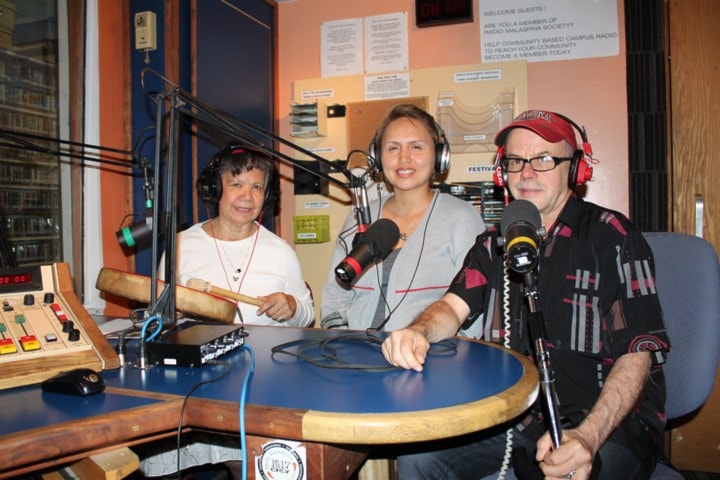A few years ago Kenny Brault came up with an idea for a radio show.
Brault, a longtime resident of Nanaimo, wanted to create a show that would highlight music by First Nations artists from across the region.
“Originally I had one vision,” Brault said. “I was just going to be playing aboriginal music.”
But what started out as a simple idea has become something far bigger.
“Then I met Geraldine [Manson] and Natasha [Bob] and Buffi [David] and everything changed,” Brault said.
After years of planning, Brault came up with the idea to create a radio show that would not only play music by aboriginal musicians, but would also educate the public on culture and history about Snuneymuxw, Stz’uminus and Snaw-Naw-As First Nations.
“I lived here for 30 years and I knew nothing of a culture that has been here for thousands of years,” Brault said.
In May of last year, Si’em’ nu Ts’ lhhwulmuhw radio show made its very first broadcast on CHLY 101.7 and continues to air on Mondays, Wednesday and Fridays.
Si’em’ nu Ts’ lhhwulmuhw, which translates to My Honoured Fellow Native People, is hosted by Brault along with Geraldine Manson, a full-time elder in residence at Vancouver Island University; Natasha Bob, a Nanaimo school district trustee and Buffi David, an educator in Ladysmith.
“The show has tremendous opportunity for local artists and musicians to share their music of course, but it also has the potential to dispel the stereotypes around First Nations people,” Bob said. “The ability to connect people that formally were not connected before is very valuable and music and arts does that.”
Si’em’ nu Ts’ lhhwulmuhw, which recently received a Neskie Award for Aboriginal Affairs and Culture Programming by the National Campus and Community Radio Association, also features interviews with a variety of guests and touches on a range of topics such as health and education.
“We were about songs and language and connecting songs and language,” Manson said. “But now we are including the history of First Nations communities and the education of First Nations communities and linking them.”
The show also highlights the positive things happening within First Nations communities.
“This whole area is so rich in culture and history and oftentimes that richness is distilled through the mainstream media,” Bob said. “There are a lot of things happening that are depressing in the news, with regards to First Nations people specifically, but this provides an opportunity to highlight the positive work that is happening, too.”
Manson says despite what is portrayed in mainstream media, First Nations languages, history and culture are as strong as ever.
“The identity of language and communities remains strong and alive,” she said. “Many [aboriginals] … are going back into universities to get their voice and status back,” she said.
Another way that aboriginals have been able to get their voice back is through access to the Internet and social media.
Paul Macedo, a communications liaison for the Western Association of Aboriginal Broadcasting, an organization representing a number of aboriginal radio stations in Western Canada, says the Internet is creating opportunities in broadcasting that previously didn’t exist.
“What the Internet has done is really lower the barrier to broadcasting,” Macedo said. “You can broadcast now right across the world and develop an audience with very limited infrastructure.”
Macedo, who has been in the radio business for over two decades, says more and more online radio shows and podcasts are being created by aboriginals.
“We’ve found that a lot of people with opinions are not just blogging and typing their comments and opinions,” Macedo said. “They are now recording podcasts and encouraging the exchange of ideas. They don’t have to have a 100,000-watt system with a 400-foot tower.”
Macedo is already seeing more and more tech-savvy musicians than ever before.
“We find that the artists are much more savvy and they are much more aware of their craft.”
Leanne Goose, recording artist from Inuvik, N.W.T., is one of the countless aboriginal artists who have taken to the Internet.
“The internet has been a tremendous tool for me to be able to get my music out to the people, out to the masses and all around the world,” she said.
Goose, a 2014 Aboriginal Peoples Choice Music Award nominee and proud Inuvialuit and Dene woman, has been involved in music her whole life, thanks in large part to her father, who is also an active musician. Goose, who has had her music played on radio stations in Canada and around the world, says when her father started out, there was little interest in aboriginal music.
“For a long time there wasn’t an indigenous music scene,” Goose explained. “There weren’t very many artists who were out there. Trailblazers such as Buffy Sainte-Marie, Robbie Robertson ... those artists set the bar and continue to do so still to this day.”
With increased access to the Internet, social media and with radio shows like Si’em’ nu Ts’ lhhwulmuhw, the aboriginal music scene is reaching new heights.
“Indigenous music is growing all around the world ... There are amazing artists doing this music and they are breaking past the borders of being an indigenous artist,” Goose said.
For more information and to listen to Si’em’ nu Ts’ lhhwulmuhw live as well as past episodes, please visit www.chly.ca.
arts@nanaimobulletin.comFollow @npescod on Twitter
